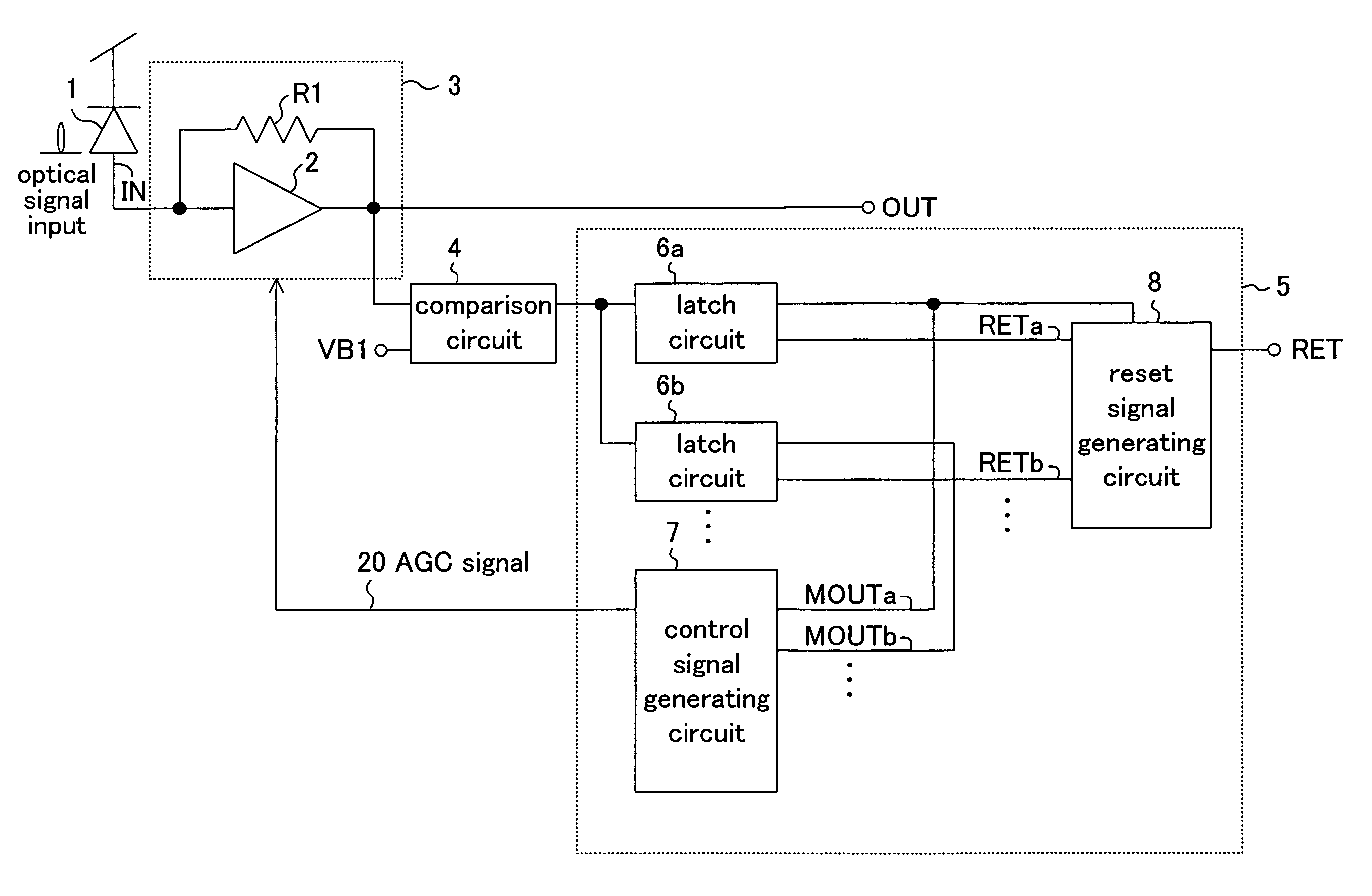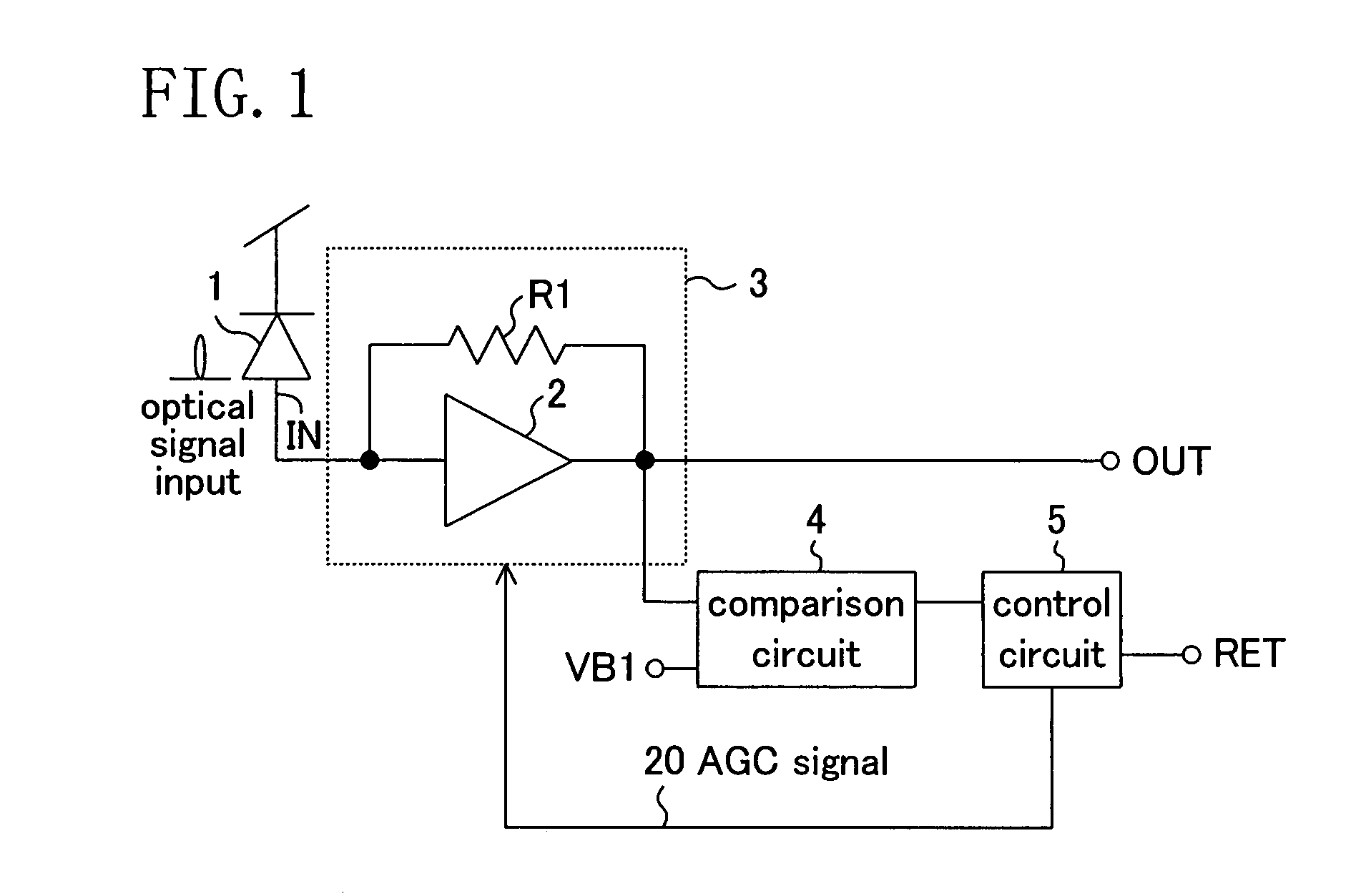Receiving circuit and optical signal receiving circuit
a technology of receiving circuit and optical signal, which is applied in the direction of electromagnetic transceivers, gain control, pulse shaping, etc., can solve the problems of waveform distortion and significant difference in received power, and achieve accurate amplifying operation, wide dynamic range, and reduced load of the output portion of the transimpedance amplifier.
- Summary
- Abstract
- Description
- Claims
- Application Information
AI Technical Summary
Benefits of technology
Problems solved by technology
Method used
Image
Examples
first embodiment
[0100]Initially, a first embodiment of a light receiving circuit of the present invention will be described with reference to FIG. 1.
[0101]The light receiving circuit of FIG. 1 comprises: a light receiving element 1 for receiving an optical input signal and outputting a current proportional to the intensity of the input light; a transimpedance amplifier 3 comprising an inversion amplifier 2 for amplifying an electrical signal which is an output current obtained by photoelectric conversion of the light receiving element 1 and a feedback resistance R1 connected between an input IN and an output OUT of the inversion amplifier 2; a comparison circuit 4 for receiving an output of the transimpedance amplifier 3, comparing the output with a reference value (first comparative value) VB1 which is set to have a certain desired value to determine the level of the output of the transimpedance amplifier 3, and outputting the comparison result; and a control circuit 5 for holding the comparison r...
second embodiment
[0182]Next, a second embodiment of the receiving circuit of the present invention will be described with reference to FIG. 8.
[0183]The receiving circuit of this embodiment in which a register circuit is used to successively hold the comparison result of the comparison circuit 4, is different from that of the first embodiment in which the control circuit 5 of the receiving circuit uses the latch circuit to hold the comparison result of the comparison circuit 4.
[0184]Here, parts other than the register circuit have been described in the first embodiment, and therefore, the same parts will not be described.
[0185]A control circuit 5 included in the receiving circuit of this embodiment of FIG. 8 comprises: shift register circuits 11a, 11b, . . . for successively holding a comparison result output from a comparison circuit 4; and a control signal generating circuit 7 for generating an AGC signal 20 which is a control signal for adjusting the gain of a transimpedance amplifier 3 based on o...
third embodiment
[0193]Next, a third embodiment of the receiving circuit of the present invention will be described with reference to FIG. 9.
[0194]The receiving circuit of this embodiment of FIG. 9 is different from that of the first embodiment in that a reference value generating circuit 12 for generating an intermediate value of the output of the transimpedance amplifier 3, and a differential amplification circuit 13 for receiving the output of the transimpedance amplifier and the output of the reference value generating circuit 12 to generate a differential signal, are further provided.
[0195]When a differential signal is required in a subsequent amplifier circuit (e.g., in data communication, etc.), since the output signal OUT is a single signal in the configuration of the first embodiment of the present invention, single-differential conversion as described in the present invention is required.
[0196]Also, the reference value generating circuit 12 can be initialized by inputting a reset signal (i...
PUM
 Login to View More
Login to View More Abstract
Description
Claims
Application Information
 Login to View More
Login to View More - R&D
- Intellectual Property
- Life Sciences
- Materials
- Tech Scout
- Unparalleled Data Quality
- Higher Quality Content
- 60% Fewer Hallucinations
Browse by: Latest US Patents, China's latest patents, Technical Efficacy Thesaurus, Application Domain, Technology Topic, Popular Technical Reports.
© 2025 PatSnap. All rights reserved.Legal|Privacy policy|Modern Slavery Act Transparency Statement|Sitemap|About US| Contact US: help@patsnap.com



